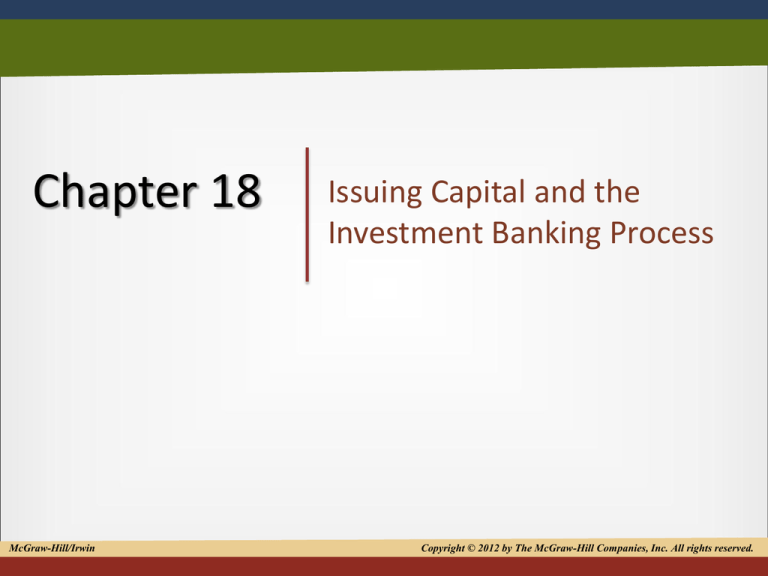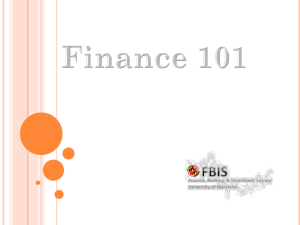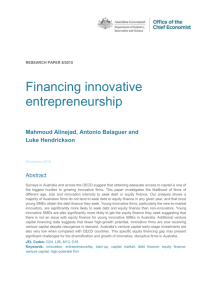
Chapter 18
McGraw-Hill/Irwin
Issuing Capital and the
Investment Banking Process
Copyright © 2012 by The McGraw-Hill Companies, Inc. All rights reserved.
1
Introduction
• Firms finance assets with capital
– Retained earnings
– Debt
– Equity
18-2
• Debt
Sources of Capital for
New and Small Firms
– Borrowing from friends and relatives
– Bank loans
– Venture capitalists
• Equity
– Venture capitalists
18-3
Debt Financing
• Bank Loans
– New and small firms rely on banks
– Availability of small-business loans was heavily
affected by the 2008 financial crisis
18-4
Bank Loans
• Small Business Loans
– Risky for commercial banks
– Banks use small-business scoring models
18-5
Bank Loans
• Mid-market firms
– Sales between $5 million and $100 million per year
– Rely on banks for funding
18-6
Credit Process Flow Chart
18-7
Loan Commitments
• Loan commitment agreements specify
– maximum loan amount
– interest rate terms
– length of loan
18-8
Fixed versus Floating Rate Loans
– Interest rates for variable-rate loans change over
the life of the loan
– Floating rate loans are set at a fixed spread over a
prevailing benchmark rate
18-9
Small Business Administration
• Created to help small businesses
• Basic loan guarantee program
– for qualified new firms that cannot get
reasonable long-term financing from other
financial institutions
18-10
Equity Financing and Expertise
• New and high-risk firms use venture capital (VC)
for financing
– Professionally managed
– VC firm takes an equity stake in the firm financed
– VC firms are actively involved in the business
18-11
Venture Capital Firms
Institutional venture capital firm types:
– Venture capital limited partnerships
– Financial venture capital firms
– Corporate venture capital firms
– Small Business Investment Companies
18-12
Angel Venture Capitalists
• Majority of VC equity investments from
wealthy individuals (angels), not institutions
• Angel VCs want
– High return
– Easy exit
18-13
The Choice to Go Public
• Choice made when firm’s capital needs exceed
its ability to raise capital
• Initial public offering (IPO) of firm’s stock
– Equity is publicly traded in stock markets for the
first time
18-14
The Choice to Go Public
• Benefits of being a public firm
– Access to a larger pool of equity capital
– Stock market provides a market value for the
firm’s stock
18-15
The Choice to Go Public
Benefits of being a public firm
– Firm’s managers can be rewarded with firm’s stock
– Original owners can diversify their holdings
18-16
The Choice to Go Public
Disadvantages of being a public firm
– Costs of an IPO
– Public disclosure of information required — may
be valuable to competitors
– Shareholders demand a great deal of information
18-17
Public Firms’
Capital Sources
• Debt Financing
– Commercial Paper
• Unsecured, short-term promissory note
• Used to raise short-term cash, often working capital
18-18
Commercial Paper
• Trading process
– Can be sold directly to investors or through broker
dealer
– Firm’s credit rating critical because commercial
paper is unsecured debt
18-19
Long-Term Debt
Corporate bonds
• Minimum denomination on publicly traded bonds is
$1,000
• Most coupon-paying bonds pay interest semiannually
18-20
Trading Process for
Corporate Bonds
• Initial sale made by public offering or private
placement to institutional investors
– Large firms use large investment banks
– Smaller firms use small regional investment banks
18-21
Trading Process for
Corporate Bonds
• Investment banks
– Firm commitment underwriting
• Entire issue bought by bank at fixed price (discount from par)
and resold at higher price
• Issuing firm has price guarantee – investment bank has risk
18-22
Firm Commitment Underwriting
Corporate Bond Issue
18-23
Trading Process for
Corporate Bonds
• Competitive sale — highest bid from group of
underwriters wins
• Negotiated sale — issuing firm negotiates with
single investment bank
18-24
Trading Process for
Corporate Bonds
Best efforts underwriting
– Underwriter does not buy issue but instead acts
as a placing or distribution agent for a fee
– Price risk remains with issuing firm
18-25
Equity Financing
• Majority of both the board of directors and
the firm’s existing stockholders must approve
any new stock issue
18-26
The Trading Process
for Corporate Equity
• Primary market
– IPO
– Seasoned offering is when the firm already has
publicly-traded shares
18-27
Primary Market Stock Transaction
18-28
The Trading Process
for Corporate Equity
The Securities and Exchange Commission (SEC)
must approve any new issues to the public
18-29
The Trading Process
for Corporate Equity
• Stock issues
– Firm commitment underwriting
– Best-efforts basis
• Registration statement
– Full disclosure of firm information, risks,
management background and securities to be
issued
18-30
The Trading Process
for Corporate Equity
• Prospectus
– Red herring prospectus is preliminary version of
the public offering prospectus
– Official prospectus describes issue
• Shelf registration allows multiple stock issues for two
years under one registration
18-31











